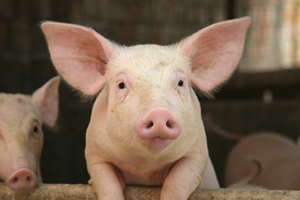FDA Acts to Fight Superbugs
Agency to End Use of Antibiotics for Growth Promotion, Boost Veterinary Oversight of Livestock Production
The U.S. Food and Drug Administration today issued a set of policies to curb the overuse of antibiotics on industrial farms. Using these drugs in animals and people contributes to the spread of resistant bacteria that can infect and hospitalize people. About 70 percent of medically important antibiotics sold in this country are for food animals, and most are used in feed without supervision of a veterinarian.
There is more work to do, but this is a promising start — especially after decades of inaction.Laura Rogers, Director, Human Health and Industrial Farming
The agency released two policies today. Final Guidance for Industry 213 states that the use of medically important antibiotics to promote animal growth is “injudicious” and asks drug makers to remove this use from the list of “indications” — FDA-approved reasons for administering a medication—on product labels. Drug companies are also expected to end over-the-counter sales of these drugs in animal feed. Companies will have 90 days to tell the agency how they will amend their labels and up to three years to make the changes.
Together with Guidance 213, the draft Veterinary Feed Directive rule, or VFD, would require food producers to obtain a veterinary order to use medically important antibiotics in animal feed. Whereas people need a doctor's prescription to take these drugs when they are sick, anyone today can buy antibiotics for animals over the counter. The public will have 90 days to comment on the draft rule.
“We commend FDA for taking the first steps since 1977 to broadly reduce antibiotic overuse in livestock,” says Laura Rogers, who directs The Pew Charitable Trusts' human health and industrial farming campaign. “There is more work to do, but this is a promising start — especially after decades of inaction.”
 Along with many public health, medical, and consumer advocates, Pew has expressed concern that the Obama administration must still address the use of antibiotics for so-called preventive purposes in the absence of disease. “It is inappropriate to routinely feed antibiotics to healthy animals just because they live in overcrowded conditions that are conducive to the spread of disease,” explains Gail Hansen, a doctor of veterinary medicine and senior officer with Pew. “Antibiotics are not the solution to that problem; better animal husbandry and hygiene are. FDA can cut down on those inappropriate uses while still allowing veterinarians to protect animal health.”
Along with many public health, medical, and consumer advocates, Pew has expressed concern that the Obama administration must still address the use of antibiotics for so-called preventive purposes in the absence of disease. “It is inappropriate to routinely feed antibiotics to healthy animals just because they live in overcrowded conditions that are conducive to the spread of disease,” explains Gail Hansen, a doctor of veterinary medicine and senior officer with Pew. “Antibiotics are not the solution to that problem; better animal husbandry and hygiene are. FDA can cut down on those inappropriate uses while still allowing veterinarians to protect animal health.”
The agency also is developing new policies to quantify how antibiotics are used in livestock production. Currently, FDA only reports annual sales of antibiotics by class, but it does not specify which animals receive the drugs or whether they are used for non-medical reasons such as growth promotion and routine disease prevention or to properly treat sick animals.
“FDA must shed more light on antibiotic use in order to ensure its policies are actually eliminating inappropriate practices,” says Rogers. “It cannot measure progress in the dark.”



